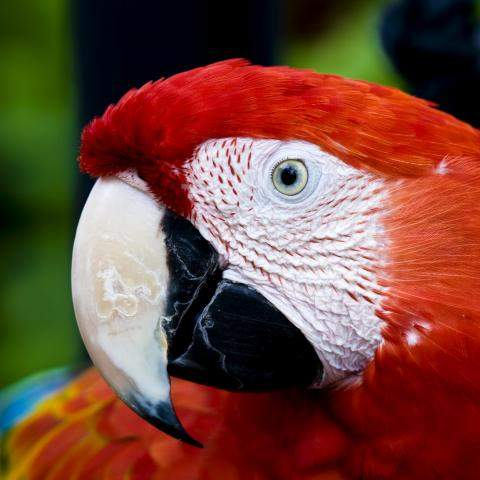Scarlet Macaw

Description
The scarlet macaw (Ara macao) is a large red, yellow, and blue South American parrot, a member of a large group of Neotropical parrots called macaws. It is native to humid evergreen forests of tropical South America. Range extends from south-eastern Mexico to the Peruvian Amazon, Colombia, Bolivia, Venezuela and Brazil in lowlands of 500 m (1,640 ft) (at least formerly) up to 1,000 m (3,281 ft). It has suffered from local extinction through habitat destruction and capture for the parrot trade, but in other areas it remains fairly common.[clarification needed] Formerly it ranged north to southern Tamaulipas. It can still be found on the island of Coiba. It is the national bird of Honduras.
It is about 81 centimetres (32 in) long, of which more than half is the pointed, graduated tail typical of all macaws, though the scarlet macaw has a larger percentage of tail than the other large macaws. The average weight is about 1 kilogram (2.2 lb). The plumage is mostly scarlet, but the rump and tail-covert feathers are light blue, the greater upper wing coverts are yellow, the upper sides of the flight feathers of the wings are dark blue as are the ends of the tail feathers, and the undersides of the wing and tail flight feathers are dark red with metallic gold iridescence. Some individuals may have green in the wings.
There is bare white skin around the eye and from there to the bill. Tiny white feathers are contained on the face patch. The upper mandible is mostly pale horn in color and the lower is black. Juveniles have dark eyes; adults have light yellow eyes.
It is frequently confused with the slightly larger green-winged macaw, which has more distinct red lines in the face and no yellow in the wing.
Scarlet macaws make very loud, high and sometimes low-pitched, throaty squawks, squeaks and screams designed to carry many miles to call for their groups.
The scarlet macaw can live up to 75 years in captivity, although a more typical lifespan is 40 to 50 years.[4]
Scientific Name
Ara Macao
Country Of Origin
Size
Life Expectancy
Noise Level
Talk / Trick Ability
Very good
Characteristics
Scarlet macaws are cuddly and playful. They need positive interaction and plenty of hard toys to chew on. Owners who favor scarlet macaws express the importance of hugging and showing affection toward this often misunderstood pet bird. A scarlet macaw’s attention easily changes from one thing to another, so it is important to offer plenty of interaction, stimulatio and entertainment. They are known as more sensitive to their surroundings than other macaws. A nuturing environment is ideal for this bird.
Behavior / Health Concerns
Scarlet macaws can be nippy without the proper socialization, but if raised from a young age in a caring household and gently taught early on positive behavior, the nipping can be greatly reduced. Because the scarlet macaw is cuddly and inquisitive, it may come toward its owner and give a little pinch with the tip of its beak. This affectionate action is often mistaken for a bad biting habit. Keeping scarlet macaw engage with interacation, playtime, toys, out-of-cage time and proper training will help in many behavioral areas. Scarlet macaws require more fat in their diet than other birds do, so provide a healthy diet that consists of pellete, fresh fruits, vegetables, whole grains and the occasional nut. They are susceptible to overgrown beaks, so offer plenty of wooden and other hard toys to give their beaks a work out. They are also susceptibel to papillomas, proventricular dilatation disease (PDD, also known as “macaw wasting” disease), polyomavirus, psittacosis and vitamin-A sensitivity.
Expert Advice
“Harder to handle than most other macaw species, but excellent companions for truly experienced parrot people. Use clear controls and consistent handling to decrease nippiness.”
Liz Wilson, CVT, CPBC
“Little dainty macaws and very beautiful, but very sneaky about biting you! No particular health concerns come to mind.”
Samuel Vaughn, DVM, Dip. ABVP – Avian Practice